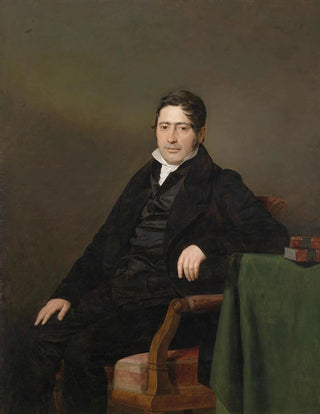Art print | Portrait of Sigmund Caspar Fischer - Ferdinand Georg Waldmüller


View from behind

Frame (optional)
Sigmund Caspar Fischer Portrait - Ferdinand Georg Waldmüller – Engaging Introduction
The "Sigmund Caspar Fischer Portrait" by Ferdinand Georg Waldmüller is much more than a simple depiction of a man. It is an open window into an era, a dive into the intimate universe of the 19th century, where the art of portraiture reaches heights of sensitivity and realism. This work, emblematic of Waldmüller's mastery, captures not only the physical features of his subject but also his essence, his soul. Through this painting, we are invited to explore the nuances of Fischer's personality, a man whose gaze seems to tell a story, a life rich in experiences and emotions. Waldmüller, through his talent, manages to transcend mere representation to offer a deeply emotional visual experience.
Style and uniqueness of the work
Ferdinand Georg Waldmüller's style is characterized by meticulous attention to detail and a subtle use of light and shadow. In the "Sigmund Caspar Fischer Portrait," each brushstroke is deliberate, each color carefully chosen to create a palpable atmosphere. Fischer's face, delicately modeled, appears almost alive, and the viewer can almost perceive the beating of his heart through the serene yet profound expression that inhabits his face. Waldmüller excels in the art of capturing not only external appearance but also the state of mind of his subjects, rendering his portraits with great humanity. The composition is balanced, and the background, though simple, highlights the central figure, allowing the work to breathe while maintaining a certain intimacy.
The artist and his influence
Ferdinand Georg Waldmüller, born in 1793, is one of the most influential representatives of Austrian Romanticism. His career, marked by success, reflects exceptional talent and a passion for art that never wanes. Waldmüller knew how to establish himself in the artistic world thanks to his ability to combine academic technique with personal sensitivity. His influence extends beyond his era, inspiring many artists who sought to capture humanity in their portraits. By emphasizing the psychological character of his models, he

Matte finish

View from behind

Frame (optional)
Sigmund Caspar Fischer Portrait - Ferdinand Georg Waldmüller – Engaging Introduction
The "Sigmund Caspar Fischer Portrait" by Ferdinand Georg Waldmüller is much more than a simple depiction of a man. It is an open window into an era, a dive into the intimate universe of the 19th century, where the art of portraiture reaches heights of sensitivity and realism. This work, emblematic of Waldmüller's mastery, captures not only the physical features of his subject but also his essence, his soul. Through this painting, we are invited to explore the nuances of Fischer's personality, a man whose gaze seems to tell a story, a life rich in experiences and emotions. Waldmüller, through his talent, manages to transcend mere representation to offer a deeply emotional visual experience.
Style and uniqueness of the work
Ferdinand Georg Waldmüller's style is characterized by meticulous attention to detail and a subtle use of light and shadow. In the "Sigmund Caspar Fischer Portrait," each brushstroke is deliberate, each color carefully chosen to create a palpable atmosphere. Fischer's face, delicately modeled, appears almost alive, and the viewer can almost perceive the beating of his heart through the serene yet profound expression that inhabits his face. Waldmüller excels in the art of capturing not only external appearance but also the state of mind of his subjects, rendering his portraits with great humanity. The composition is balanced, and the background, though simple, highlights the central figure, allowing the work to breathe while maintaining a certain intimacy.
The artist and his influence
Ferdinand Georg Waldmüller, born in 1793, is one of the most influential representatives of Austrian Romanticism. His career, marked by success, reflects exceptional talent and a passion for art that never wanes. Waldmüller knew how to establish himself in the artistic world thanks to his ability to combine academic technique with personal sensitivity. His influence extends beyond his era, inspiring many artists who sought to capture humanity in their portraits. By emphasizing the psychological character of his models, he






